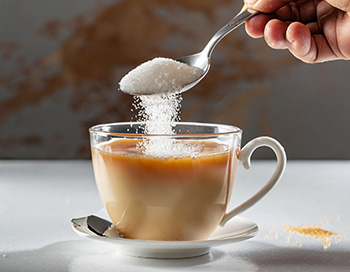by Peter Barclay
A few weeks after my mini-stroke—a transient ischemic attack (TIA)—Catherine and I sat facing a specialist consultant in a cramped clinic room not far from our home. He leaned back in his chair, looked at his computer screen, and said something that stopped both of us in our tracks:
“I believe in keeping patients as close to the tipping point as possible. That’s what I do for my wife.”
I asked for clarification. He explained that, for his stroke patients, it was best to keep medications just below the point where they might lose balance or “tip out”. That, he said, produced the best long-term results. The phrase lodged in my mind — a mix of challenge, caution and more than a small amount of ongoing concern.
That was eleven years ago, and perhaps it was sound advice. But it didn’t address some nagging thoughts: What if I made my diet much healthier? Could that impact my balance and reduce (or even increase) my risk of instability, or of tipping out, as he so quaintly put it? Would it even make much difference to the numbers he was looking at on his screen?
That part was left unsaid, and as we found out much later, it was the wrong place for that kind of conversation anyway. I was reminded of it when I recently came across an article in the New York Times – falls among older people are not just common, it said, they’re a public health crisis.
According to the World Health Organisation (2024), around 37 million falls requiring medical attention occur each year globally, with older adults at greatest risk. In countries like the UK, falls are the leading cause of injury-related deaths in this age group.
An unexpected fall does more than cause physical harm; it can also have lasting emotional effects. It can fracture confidence, limit independence, and trigger a downward spiral of mobility loss. After a TIA, the fear of falling takes on a sharper edge; dizziness, weakness, or balance loss can lead to potentially devastating outcomes.
But what’s often overlooked is how much of this risk is tied not just to age or illness, but to the medications we’re prescribed.
The hidden risk
Many older adults take multiple medications — a phenomenon termed polypharmacy. It’s now widely recognised that some drugs, alone or in combination, can affect balance, coordination, alertness, and muscle strength.
The British Geriatrics Society (2023) notes that sedatives, certain blood pressure medicines, antidepressants, and medications affecting blood sugar can all contribute to what geriatricians call “drug-induced falls.”
For stroke survivors, including those who experienced a TIA, prescriptions often include:
- Antiplatelet agents (like aspirin or clopidogrel)
- Antihypertensives (to reduce stroke risk)
- Statins (to control cholesterol)
- Blood sugar-control agents if diabetes is a factor
While essential in preventing another event, these medicines aren’t without side effects. Even slight changes in blood pressure or alertness can mean the difference between steady footing and a stumble.
What the research says
Recent work has shed considerable light on the connection between medication and falls.
- BMJ (2023) published a large-scale study showing that older adults taking multiple cardiovascular and psychotropic drugs were 38% more likely to report at least one fall within 12 months.
- The Lancet Healthy Longevity (2024) highlighted that “de-prescribing” — safely reducing unnecessary medications under medical supervision — led to a measurable drop in fall incidence among frail adults over 75.
- Harvard Medical School (2022) found that switching older adults from sedating antihistamines to non-sedating alternatives reduced nighttime falls by 21%.
These studies underline an important point: medications can save lives, but they also require careful balance — and sometimes adjustment — to reduce side effects that impact stability.
As I’ve learned since, when the follow-up clinician I visited spoke about staying close to the tipping point, he was referring to functional reserve — the body’s capacity to function under stress without losing control. In older adults, this reserve is smaller. Each health event, medication change, or bout of illness further narrows the margin.
The idea is to keep pushing your limits just enough to maintain muscle strength, cardiovascular function, and coordination, but not so far that you induce fatigue or risk injury.
The trouble is that reserve can be eroded by subtly harmful side effects of medication — especially when combined with age-related changes in vision, reaction time, and muscle strength.
Where diet fits in
Here’s the advice gap I experienced: while I was told to stay close to my physical tipping point, no medical professional at the time discussed how nutrition could broaden that margin.
A growing body of research now connects dietary patterns to fall risk. Nutritional deficiencies — especially in protein, vitamin D, calcium, and B vitamins — can lead to weaker muscles, slower reflexes, and poorer neurological function.
- Journal of Nutrition, Health & Aging (2024) reported that older adults following a Mediterranean-style diet had a 30% lower risk of falls over a four-year follow-up.
- European Society for Clinical Nutrition and Metabolism (ESPEN) Guidelines 2023 recommend at least 1.0–1.2 g/kg/day of protein for older adults to preserve muscle mass.
- Studies from University College London (2022) found that correcting vitamin D deficiency in frail patients reduced fall frequency by 27%.
Strikingly, these benefits come from something that doesn’t require a prescription — diet change — and yet many older patients are never advised to consider it alongside their medication regimen.
This is particularly relevant for people (like myself) who strictly follow the WFPB eating regimen. However, thanks to this movement’s close association with a huge range of respected MDs and nutritionists, we’re never short of access to sound advice.
Polypharmacy and body resilience
Balancing medication load, physical activity, and nutrition might be the closest thing we have to a “falls prevention formula.”
The UK’s National Institute for Health and Care Excellence (NICE) now recommends annual medication reviews for older adults; however, uptake is uneven. Many patients are reluctant to question prescriptions, and clinicians under time pressure may prioritise disease prevention over functional resilience.
After my TIA, I was given prescriptions to control risk factors. However, it was only after reading, listening to, and taking advice from our WFPB leaders that I later learned how combining strength training, balance exercises, and a better diet would help buffer the effects of my medications and keep me steady.
Some practical steps
Here’s what the current thinking, backed by research, suggests:
- Get a comprehensive medication review
- Ask your GP or pharmacist to check each drug for known fall-related side effects.
- Don’t stop medication abruptly — adjustments (usually downward) will be necessary but should be supervised.
- Build balance into daily life
- Programs like the Otago Exercise Programme and Tai Chi for Arthritis and Falls Prevention have strong evidence for reducing falls in older adults.
- Eat for muscle and nerve health
- WFPB, Mediterranean-style diet or DASH diet, rich in fruits, vegetables, whole grains, and lean protein.
- Ensure adequate intake of vitamin D, B12, and magnesium.
- Monitor your tipping point
- Note when fatigue or dizziness sets in during activity.
- Gradually extend limits, but avoid sudden overexertion.
- Stay hydrated
- Dehydration can worsen low blood pressure from medication, leading to dizziness.
- Integrate with medical advice
- Tell your healthcare team about any complementary strategies — whether dietary, exercise-based, or lifestyle — so they can adjust plans accordingly.
The missing connection
One of the frustrations I’ve faced — and that many older adults experience — is the fragmentation of advice. Neurologists focus on preventing another TIA, cardiologists on blood pressure, dietitians on nutrition, and physiotherapists on muscle strength. Rarely is there a single conversation tying these elements together.
Falls prevention requires a joined-up approach — reviewing medication, diet, activity, and mental resilience in a single plan.
As the Royal College of Physicians (2024) now urges, multidisciplinary falls clinics should become a default referral for anyone over 70 who’s had a stroke or TIA. Evidence suggests that when medication, exercise, and diet changes are addressed together, fall risk drops significantly.
Looking back, I think I’ve taken my consultant’s “tipping point” advice to heart — but I’ve broadened it. For me, it now means:
- Staying physically active enough to challenge balance daily.
- Eating to give my muscles and neurons every possible advantage.
- Working with my GP to keep my (now low-level) drug regimen effective but not excessive.
- Listening closely to my body’s warning signs.
Unexpected falls aren’t inevitable, even as we age. They are, in many cases, a complex side effect of how modern medicine works for us — and sometimes, how it works against us.
Medication after a TIA can be lifesaving. But it can also nudge us closer to instability if we’re not vigilant. The “tipping point” is real — and so is our ability to push it back through informed diet, exercise, and regular medication reviews.
The challenge, of course, is obtaining the right advice at the right time and in the right context. If our healthcare systems integrated dietary guidance into medication management for older adults, many of us could stand a little taller and a little steadier.
After all, balance isn’t just about muscle and brain chemistry — it’s about how we live on the edge… without falling off it.
References:
- British Geriatrics Society. Medication and Falls in Older People. 2023.
- BMJ. Polypharmacy and Risk of Falls in Older Adults: A Cohort Study. 2023.
- The Lancet Healthy Longevity. Deprescribing Interventions and Fall Risk Reduction. 2024.
- World Health Organization. Falls Fact Sheet. 2024.
- ESPEN Guidelines. Nutritional Management in Older Adults. 2023.
- University College London. Vitamin D Supplementation and Fall Reduction in Frail Elderly. 2022.





